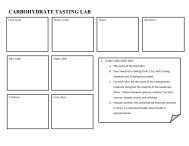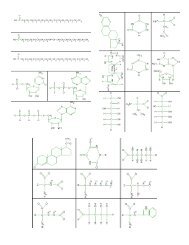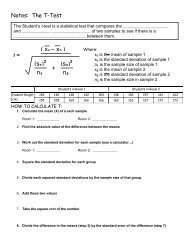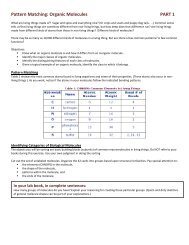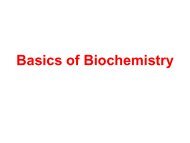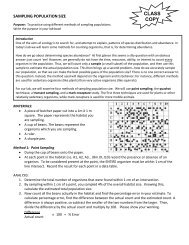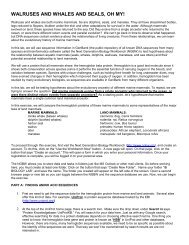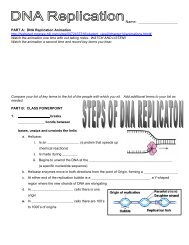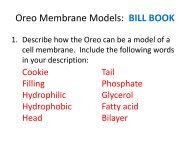Reconstructing and Using Phylogenies 16 - W.H. Freeman
Reconstructing and Using Phylogenies 16 - W.H. Freeman
Reconstructing and Using Phylogenies 16 - W.H. Freeman
You also want an ePaper? Increase the reach of your titles
YUMPU automatically turns print PDFs into web optimized ePapers that Google loves.
<strong>Reconstructing</strong> <strong>and</strong><strong>Using</strong> <strong>Phylogenies</strong> <strong>16</strong>W.H. <strong>Freeman</strong> & Company <strong>and</strong> Sinauer Associates, Inc ©2010Green fluorescent protein (GFP) wasdiscovered in 1962 when Osamu Shimomura,an organic chemist <strong>and</strong> marinebiologist, led a team that was ableto purify the protein from the tissues ofthe bioluminescent jellyfish Aequoreavictoria. Some 30 years after its initialdiscovery, Martin Chalfie had the idea(<strong>and</strong> the technology) to link the genefor GFP to other protein-coding genes,so that the expression of specific genesof interest could be visualized in glowinggreen within cells <strong>and</strong> tissues ofliving organisms (see Figure 13.6). Thiswork was extended by Roger Tsien,who changed some of the amino acidswithin GFP to create proteins of severaldistinct colors. Different coloredproteins meant that the expression ofa number of different proteins couldbe visualized <strong>and</strong> studied in the sameorganism at the same time. These threescientists were awarded the 2008 NobelPrize in Chemistry for the isolation<strong>and</strong> development of GFP for visualizinggene expression.Although Tsien was able to producedifferent colored proteins, he could notproduce a red protein. This was frustrating;a red fluorescent protein would beparticularly useful to biologists becausered light penetrates tissues more easilythan do other colors. Tsien’s work stimulatedMikhail Matz to look for new fluorescentproteins in corals (which are relativesof the jellyfishes). Among the differentspecies he studied, Matz found coral proteinsthat fluoresced in various shades ofgreen, cyan (blue-green)—<strong>and</strong> red.How had fluorescent red pigmentsevolved among the corals, given thatthe necessary molecular changes hadeluded Tsien? To answer this question,Matz sequenced the genes ofthe fluorescent proteins <strong>and</strong> usedthese sequences to reconstruct theevolutionary history of the amino acidchanges that produced different colors indifferent species of corals.Matz’s work showed that the ancestralfluorescent protein in corals was green,<strong>and</strong> that red fluorescent proteins evolvedin a series of gradual steps. His analysis allowedhim to retrace these steps in detail.Such an evolutionary history, as depictedin a tree of relationships among lineages,is called a phylogeny.The evolution of many aspects of anorganism’s biology can be reconstructedusing phylogenetic methods. This informationis used in all fields of biology tounderst<strong>and</strong> the structure, function, <strong>and</strong>behavior of organisms.QHowQUESTIONare phylogenetic methodsused to resurrect proteinsequences from extinct organisms?The reef-building coralAcropora millepora showscyan <strong>and</strong> red fluorescence.This photograph was takenunder a fluorescent microscopethat affects the colorswe see; the colors are perceiveddifferently by oceananimals, depending in part onthe depth of the water.kEY CONCEPTS<strong>16</strong>.1 All of Life Is Connectedthrough Its EvolutionaryHistory<strong>16</strong>.2 Phylogeny Can Be Reconstructedfrom Traits ofOrganisms<strong>16</strong>.3 Phylogeny MakesBiology Comparative<strong>and</strong> Predictive<strong>16</strong>.4 Phylogeny Is the Basis ofBiological Classification
310 Chapter <strong>16</strong> | <strong>Reconstructing</strong> <strong>and</strong> <strong>Using</strong> <strong>Phylogenies</strong>W.H. <strong>Freeman</strong> & Company <strong>and</strong> Sinauer Associates, Inc ©2010concept<strong>16</strong>.1The sequencing of complete genomes from many diverse specieshas confirmed what biologists have long suspected: all of life isrelated through a common ancestor. The common ancestry of lifeexplains why the general principles of biology apply to all organisms.Thus we can learn much about how the human genomeworks by studying the biology of model organisms because weshare a common evolutionary history with those organisms. Theevolutionary history of these relationships is known as phylogeny,<strong>and</strong> a phylogenetic tree is a diagrammatic reconstructionof that history.Phylogenetic trees are commonly used to depict the evolutionaryhistory of species, populations, <strong>and</strong> genes. For manyyears such trees have been constructed based on physical structures,behaviors, <strong>and</strong> biochemical attributes. Now, as genomesare sequenced for more <strong>and</strong> more organisms, biologists are ableto reconstruct the history of life in ever greater detail.In Chapter 15, we discussed why we expect populations oforganisms to evolve over time. Such a series of ancestor <strong>and</strong> descendantpopulations forms a lineage, which we can depict as aline drawn on a time axis:TimeA species, population, orgene at one point in time……becomes a lineage as we followits descendants through time.What happens when a single lineages divides into two? For example,a geographic barrier may divide an ancestral populationinto two descendant populations that no longer interact withone another. We depict such an event as a split, or node, in aphylogenetic tree. Each of the descendant populations give riseto a new lineage, <strong>and</strong> as these independent lineages evolve, newtraits arise in each:NodeAll of Life Is Connected through ItsEvolutionary HistoryA split occurs when theancestral lineage divides intotwo descendant lineages…As the lineages continue to split over time, this history can berepresented in the form of a branching tree that can be used totrace the evolutionary relationships from the ancient commonancestor of a group of species, through the various lineage splits,up to the present populations of the organisms:TimePOL HillisSinauer AssociatesMorales StudioFigure INTXT<strong>16</strong>.03 Date 06-17-10PresentA phylogenetic tree may portray the evolutionary history ofall life forms; of a major evolutionary group (such as the insects);of a small group of closely related species; or in some cases, eventhe history of individuals, populations, or genes within a species.The common ancestor of all the organisms in the tree forms theroot of the tree. The depictions of phylogenetic trees in this bookare rooted at the left, with time flowing from left (earliest) toright (most recent):Commonancestor(root)15The positions of the nodes onthe time scale indicate the timesof divergence events.ChimpanzeeHumanGorillaOrangutan10 5 0Time (millions of years ago) PresentTimePOL HillisSinauer AssociatesMorales StudioFigure INTXT<strong>16</strong>.01 Date 06-17-10…<strong>and</strong> each lineagecontinues to evolveindependently asdifferent traits(represented by reddots) arise.The timing of splitting events in lineages is shown by the positionof nodes on a time axis. These splits represent events whereone lineage diverged into two, such as a speciation event (for atree of species), a gene duplication event (for a tree of genes), or atransmission event (for a tree of viral lineages transmitted througha host population). The time axis may have an explicit scale, or itmay simply show the relative timing of divergence events.In this book’s illustrations, the order in which nodes are placedalong the horizontal (time) axis has meaning, but the vertical
5.2 <strong>16</strong>.1 All of Life Is Connected through Its Evolutionary History 311distance between the branches does not. Vertical distances havebeen adjusted for legibility <strong>and</strong> clarity of presentation; they donot correlate with the degree of similarity or difference betweengroups. Note too that lineages can be rotated around nodes in thetree, so the vertical order of lineages is also largely arbitrary:CommonancestorLampreyPerchW.H. <strong>Freeman</strong> & Company <strong>and</strong> Sinauer Associates, Inc ©2010ChimpanzeeHumanGorillaOrangutanHumanChimpanzeeGorillaOrangutanAny group of species that we designate with a name is ataxon (plural taxa). Examples of familiar taxa include humans,primates, mammals, <strong>and</strong> vertebrates; in this series, each taxon isalso a member of the next, more inclusive taxon. Any taxon thatconsists of all the evolutionary descendants of a common ancestoris called a clade. Clades can be identified by picking any pointon a phylogenetic tree <strong>and</strong> from that point tracing all the descendantlineages to the tips of the terminal branches (Figure <strong>16</strong>.1).Two species that are each other’s closest relatives are called sisterspecies; similarly, any two clades that are each other’s closestrelatives are sister clades.Before the 1980s, phylogenetic trees tended to be seen onlyin the literature on evolutionary biology, especially in the areaof systematics—the study <strong>and</strong> classification of biodiversity. Butalmost every journal in the life sciences published during the lastfew years contains phylogenetic trees. Trees are widely used inmolecular biology, biomedicine, physiology, behavior, ecology,<strong>and</strong> virtually all other fields of biology. Why have phylogeneticstudies become so widespread?Phylogenetic trees are the basis ofcomparative biologyPOL HillisIn Sinauer biology, Associates we study life at all levels of organization—fromMorales Studiogenes, Figure INTXT<strong>16</strong>.05 cells, organisms, Date 06-17-10 populations, <strong>and</strong> species to the majordivisions of life. In most cases, however, no individual gene ororganism (or other unit of study) is exactly like any other geneor organism that we investigate.Consider the individuals in your biology class. We recognizeeach person as an individual human, but we know that no twoare exactly alike. If we knew everyone’s family tree in detail, thegenetic similarity of any pair of students would be more predictable.We would find that more closely related students havemany more traits in common (from the color of their hair to theirsusceptibility or resistance to diseases). Likewise, biologists usephylogenies to make comparisons <strong>and</strong> predictions about sharedtraits across genes, populations, <strong>and</strong> species.The evolutionary relationships among species, as representedin the tree of life, form the basis for biological classification. Biologistsestimate that there are tens of millions of species onEarth. So far, however, only about 1.8 million species have beenclassified—that is, formally described <strong>and</strong> named. New speciesMammalsAmniotesTetrapodsVertebratesSalam<strong>and</strong>erLizardCrocodilePigeonMouseChimpanzeeFIGURE <strong>16</strong>.1 Clades Represent All the Descendants of aCommon Ancestor All clades are subsets of larger clades, withall of life as the most inclusive taxon. In this example, the groupscalled mammals, amniotes, tetrapods, <strong>and</strong> vertebrates representsuccessively larger clades. Only a few species within each clade arerepresented on this tree.are being discovered all the time <strong>and</strong> phylogenetic analyses areconstantly reviewed <strong>and</strong> revised, so our knowledge of the treeof life is far from complete. Yet knowledge of evolutionary relationshipsis essential for making comparisons in biology, sobiologists build phylogenies for groups of interest as the needarises. The tree of life’s evolutionary framework allows us tomake many predictions about the behavior, ecology, physiology,genetics, <strong>and</strong> morphology of species that have not yet beenstudied in detail.When biologists compare species, they observe traits that differwithin the group of interest <strong>and</strong> try to ascertain when thesePrinciples of LIFE SadavaSinauer AssociatesMorales traits Studio evolved. In many cases, investigators are interested in howFigure the <strong>16</strong>.01 evolution Date of 06-<strong>16</strong>-10 a trait relates to environmental conditions or selectivepressures. For instance, scientists have used phylogeneticanalyses to discover changes in the genome of human immunodeficiencyvirus that confer resistance to particular drug treatments.The association of a particular genetic change in HIV witha particular treatment provides a hypothesis about the evolutionof resistance that can be tested experimentally.Any features shared by two or more species that have been inheritedfrom a common ancestor are said to be homologous. Homologousfeatures may be any heritable traits, including DNAsequences, protein structures, anatomical structures, <strong>and</strong> evensome behavior patterns. For example, all living vertebrates havea vertebral column, as did the ancestral vertebrate. Therefore, thevertebral column is judged to be homologous in all vertebrates.
312 Chapter <strong>16</strong> | <strong>Reconstructing</strong> <strong>and</strong> <strong>Using</strong> <strong>Phylogenies</strong>W.H. <strong>Freeman</strong> & Company <strong>and</strong> Sinauer Associates, Inc ©2010Derived traits provide evidence of evolutionaryrelationshipsIn tracing the evolution of a character, biologists distinguish betweenancestral <strong>and</strong> derived traits. Each character of an organismevolves from one condition (the ancestral trait) to another condition(the derived trait). Derived traits that are shared amonga group of organisms <strong>and</strong> are also viewed as evidence of thecommon ancestry of the group are called synapomorphies (syn,“shared”; apo, “derived”; morph, “form,” referring to the “form”of a trait). Thus the vertebral column is considered a synapomorphy—ashared, derived trait—of the vertebrates. (The ancestraltrait was an undivided supporting rod.)Not all similar traits are evidence of relatedness. Similar traitsin unrelated groups of organisms can develop for either of thefollowing reasons:• Independently evolved traits subjected to similar selectionpressures may become superficially similar, a phenomenoncalled convergent evolution. For example, although the wingbones of bats <strong>and</strong> birds are homologous, having been inheritedfrom a common tetrapod ancestor, the wings of bats <strong>and</strong> birdsare not homologous because they evolved independently fromthe forelimbs of different nonflying ancestors (Figure <strong>16</strong>.2).• A character may revert from a derived state back to an ancestralstate in an event called an evolutionary reversal. Forexample, the derived limbs of terrestrial tetrapods evolvedfrom the ancestral fins of their aquatic ancestors. Then, withinthe mammals, the ancestors of modern cetaceans (whales <strong>and</strong>dolphins) returned to the ocean, <strong>and</strong> cetacean limbs evolved toBat wingBird wingBones shown in the samecolor are homologous.FIGURE <strong>16</strong>.2 The Bones Are Homologous, the Wings AreNot The supporting bone structures of both bat wings <strong>and</strong> birdwings are derived from a common tetrapod (four-limbed) ancestor<strong>and</strong> are thus homologous. However, the wings themselves—anadaptation for flight—evolved independently in the two groups.once again resemble their ancestral state—fins. The superficialsimilarity of cetacean <strong>and</strong> fish fins does not suggest a closerelationship between these groups; the similarity arises fromevolutionary reversal.Similar traits generated by convergent evolution <strong>and</strong> evolutionaryreversals are called homoplastic traits or homoplasies.A particular trait may be ancestral or derived, depending onour point of reference. For example, all birds have feathers. Weinfer from this that feathers (which are highly modified scales)were present in the common ancestor of modern birds. Therefore,we consider the presence of feathers to be an ancestral traitfor any particular group of modern birds, such as the songbirds.However, feathers are not present in any other living animals. Inreconstructing a phylogeny of all living vertebrates, the presenceof feathers is a derived trait found only among birds, <strong>and</strong> thus isa synapomorphy of the birds.Do You Underst<strong>and</strong> Concept <strong>16</strong>.1?• What biological processes are represented in aphylogenetic tree?• Why is it important to consider only homologouscharacters in reconstructing phylogenetic trees?• What are some reasons that similar traits might ariseindependently in species that are only distantlyrelated? Can you think of examples among familiarorganisms?Phylogenetic analyses of evolutionary history have become increasinglyimportant to many types of biological research in recentyears, <strong>and</strong> they are the basis for the comparative nature ofbiology. For the most part, however, evolutionary history cannotbe observed directly. How, then, do biologists reconstruct thepast?concept<strong>16</strong>.2Phylogeny Can Be Reconstructedfrom Traits of OrganismsConsider the eight vertebrate animals listed in Table <strong>16</strong>.1: lamprey,perch, salam<strong>and</strong>er, lizard, crocodile, pigeon, mouse, <strong>and</strong>chimpanzee. To illustrate how the phylogenetic tree in Figure<strong>16</strong>.3 is constructed, we assume initially that a given derived traitarose only once during the evolution of these animals (there hasbeen no convergent evolution), <strong>and</strong> that no derived traits werelost from any of the descendant groups (there has been no evolutionaryreversal). For simplicity, we have selected traits that areeither present (+) or absent (–).In a phylogenetic study, the group of organisms of primaryinterest is called the ingroup. As a point of reference, an ingroupis compared with an outgroup: a species or group known tobe closely related to but phylogenetically outside the group ofinterest. If the outgroup is known to have diverged before the ingroup,the outgroup can be used to determine which traits of the
5.2 <strong>16</strong>.2 Phylogeny Can Be Reconstructed from Traits of Organisms 313TABLE <strong>16</strong>.1 Eight Vertebrates <strong>and</strong> the Presence or Absence of Some Shared Derived Traitsderived traitW.H. <strong>Freeman</strong> & Company <strong>and</strong> Sinauer Associates, Inc ©2010CLAWS mammary keratinoustaxon jaws lungs or nails gizzard feathers fur gl<strong>and</strong>s scalesLamprey (outgroup) – – – – – – – –Perch + – – – – – – –Salam<strong>and</strong>er + + – – – – – –Lizard + + + – – – – +Crocodile + + + + – – – +Pigeon + + + + + – – +Mouse + + + – – + + _Chimpanzee + + + – – + + _ingroup are derived (i.e., evolved within the ingroup) <strong>and</strong> whichare ancestral (i.e., evolved before the origin of the ingroup). Thelamprey belongs to a group of jawless fishes thought to haveseparated from the lineage leading to the other vertebrates beforethe jaw arose. Therefore, we have specified the lamprey as theoutgroup for our analysis. Because derived traits were acquiredby other members of the vertebrate lineage after they divergedfrom the outgroup, any trait that is present in both the lamprey<strong>and</strong> the other vertebrates is judged to be ancestral.We begin by noting that the chimpanzee <strong>and</strong> mouse sharetwo derived traits—mammary gl<strong>and</strong>s <strong>and</strong> fur—that are absentThe earliest branch in the treerepresents the evolutionary splitbetween the outgroup (lamprey)<strong>and</strong> the ingroup (the remainingspecies of vertebrates).Derived traits areindicated alonglineages in whichthey evolved.CommonancestorJawsLungsClawsor nailsin both the outgroup <strong>and</strong> in the other species of the ingroup.Therefore, we infer that mammary gl<strong>and</strong>s <strong>and</strong> fur are derivedtraits that evolved in a common ancestor of chimpanzees <strong>and</strong>mice after that lineage separated from the lineages leading tothe other vertebrates. These characters are synapomorphies thatunite chimpanzees <strong>and</strong> mice (as well as all other mammals, althoughwe have not included other mammalian species in thisexample). By the same reasoning, we can infer that the othershared derived traits are synapomorphies for the various groupsin which they are expressed. For instance, keratinous scales are asynapomorphy of the lizard, crocodile, <strong>and</strong> pigeon.FIGURE <strong>16</strong>.3 Inferring a Phylogenetic Tree This phylogenetic tree was constructedfrom the information given in Table <strong>16</strong>.1 using the parsimony principle. Each cladein the tree is supported by at least one shared derived trait, or synapomorphy.KeratinousscalesGizzardFeathersLamprey(outgroup)PerchSalam<strong>and</strong>erLizardCrocodilePigeonThe lamprey isdesignated asthe outgroup.IngroupFur; mammarygl<strong>and</strong>sMouseChimpanzee
314 Chapter <strong>16</strong> | <strong>Reconstructing</strong> <strong>and</strong> <strong>Using</strong> <strong>Phylogenies</strong>W.H. <strong>Freeman</strong> & Company <strong>and</strong> Sinauer Associates, Inc ©2010Table <strong>16</strong>.1 also tells us that, among the animals in our ingroup,the pigeon has a unique trait: the presence of feathers.Feathers are a synapomorphy of birds <strong>and</strong> their extinct relatives.However, because we only have one bird in this example, thepresence of feathers provides no clues concerning relationshipsamong these eight species of vertebrates. However, gizzards arefound in both birds <strong>and</strong> crocodiles, so this trait is evidence of aclose relationship between birds <strong>and</strong> crocodilians.By combining information about the various synapomorphies,we can construct the phylogenetic tree in Figure <strong>16</strong>.3. Weinfer from our information that mice <strong>and</strong> chimpanzees—theonly two animals that share fur <strong>and</strong> mammary gl<strong>and</strong>s—share amore recent common ancestor with each other than they do withpigeons <strong>and</strong> crocodiles. Otherwise, we would need to assumethat the ancestors of pigeons <strong>and</strong> crocodiles also had fur <strong>and</strong>mammary gl<strong>and</strong>s but subsequently lost them; these additionalassumptions are unnecessary in this case.This particular tree was easy to construct because it is basedon a very small sample of traits, <strong>and</strong> the derived traits we examinedevolved only once <strong>and</strong> were never lost after they appeared.Had we included a snake in the group, our analysis would nothave been as straightforward. We would need to examine additionalcharacters to determine that snakes evolved from a groupof lizards that had limbs. In an evolutionary reversal, limbs werelost in the ancestors of snakes as an adaptation to a subterraneanexistence.Typically, biologists construct phylogenetic trees using hundredsor thous<strong>and</strong>s of traits. With larger data sets, we would expectApply the ConceptPhylogeny can be reconstructed from traits of organismsThe matrix below supplies data for seven l<strong>and</strong> plants <strong>and</strong> anoutgroup (an aquatic plant known as a stonewort). Each traitis scored as either present (+) or absent (–) in each of the plants.Use this data matrix to reconstruct the phylogeny of l<strong>and</strong> plants<strong>and</strong> answer the questions.1. Which two of these taxa are most closely related?to observe traits that have changed more than once, <strong>and</strong> thuswould expect to see convergence <strong>and</strong> evolutionary reversal. Howdo we determine which traits are synapomorphies <strong>and</strong> which arehomoplasies? One way is to invoke the principle of parsimony.yourBioPortal.comGo to WEB ACTIVITY <strong>16</strong>.1Constructing a Phylogenetic Tree<strong>and</strong> INTERACTIVE TUTORIAL <strong>16</strong>.1Phylogeny: Evolution of TraitsParsimony provides the simplest explanation forphylogenetic dataIn its most general form, the parsimony principle states that thepreferred explanation of observed data is the simplest explanation.Applying the principle of parsimony to the reconstructionof phylogenies entails minimizing the number of evolutionarychanges that need to be assumed over all characters in all groupsin the tree. In other words, the best hypothesis under the parsimonyprinciple is one that requires the fewest homoplasies. Thisapplication of parsimony is a specific case of a general principleof logic called Occam’s razor: The best explanation is the one thatbest fits the data while making the fewest assumptions. Morecomplicated explanations are accepted only when the evidencerequires them. Phylogenetic trees represent our best estimatesabout evolutionary relationships, given the evidence available.2. Plants that produce seeds are known as seed plants. Whatis the sister group to the seed plants among these taxa?3. Which two traits evolved along the same branch of yourreconstructed phylogeny?4. Are there any homoplasies in your reconstructedphylogeny?PersistentlyProtected green VASCULAR mEgaphyllsTaxON Embryos True roots sporophyte cells Stomata (true leaves) SeedsStonewort (outgroup) – – – – – – –Liverwort + – – – – – –Pine tree + + + + + + +Bracken fern + + + + + + –Club moss + + + + + – –Sphagnum moss + – – – + – –Hornwort + – + – + – –Sunflower + + + + + + +Trait
<strong>16</strong>.2 5.2 Phylogeny Can Be Reconstructed from Traits of Organisms 315W.H. <strong>Freeman</strong> & Company <strong>and</strong> Sinauer Associates, Inc ©2010As with all analyses in science, phylogenetic trees are continuallymodified as additional information is obtained.<strong>Phylogenies</strong> are reconstructed from manysources of dataNaturalists have constructed various forms of phylogenetic treesfor more than 150 years. In fact, the only figure in the first editionof Darwin’s Origin of Species was a conceptual diagram of a phylogenetictree. Phylogenetic tree construction has been revolutionizedby the advent of computer software that allows us to considerfar more data <strong>and</strong> analyze far more traits than could ever beforebe processed. Combining these advances in methodology with themassive comparative data sets being generated through genomesequencing <strong>and</strong> other molecular studies, biologists are learningdetails about the tree of life at a remarkable pace.Any trait that is genetically determined—<strong>and</strong> therefore heritable—canbe used in a phylogenetic analysis. Evolutionaryrelationships can be revealed through studies of morphology,development, the fossil record, behavioral traits, <strong>and</strong> moleculartraits such as DNA <strong>and</strong> protein sequences.morphology An important source of phylogenetic informationis morphology: the presence, size, shape, <strong>and</strong> other attributesof body parts. Since living organisms have been observed, depicted,<strong>and</strong> studied for millenia, we have a wealth of recordedmorphological data as well as extensive museum <strong>and</strong> herbariumcollections of organisms whose traits can be measured. Newtechnological tools, such as the electron microscope <strong>and</strong> computedtomography (CT) scans, enable systematists to examine<strong>and</strong> analyze the structures of organisms at much finer scales thanwas formerly possible.Most species are described <strong>and</strong> known primarily by theirmorphology, <strong>and</strong> morphology still provides the most comprehensivedata set available for many taxa. The morphologicalfeatures that are important for phylogenetic analysis are oftenspecific to a particular group. For example, the presence, development,shape, <strong>and</strong> size of various features of the skeletal systemare important in vertebrate phylogeny, whereas the structures ofthe floral organs (petals, carpels, stamens <strong>and</strong> sepals; see p. 796)are important for studying the relationships among floweringplants.<strong>Reconstructing</strong> the evolutionary relationships of most extinctspecies depends almost exclusively on morphological comparisons.Fossils show us where <strong>and</strong> when organisms lived in thepast <strong>and</strong> give us an idea of what they looked like. Fossils provideimportant evidence that helps distinguish ancestral fromderived traits. The fossil record can also reveal when lineagesdiverged <strong>and</strong> began their independent evolutionary histories.Furthermore, in groups with few species that have survived tothe present, information on extinct species is often critical to anunderst<strong>and</strong>ing of the large divergences among the survivingspecies. The fossil record is limited, however; for some groups,few or no fossils have been found, <strong>and</strong> for others the fossil recordis fragmentary.Although useful, morphological approaches to phylogeneticanalysis do have limitations. Some taxa exhibit little morphologicaldiversity, despite great species diversity. For example, the phylogenyof the leopard frogs of North <strong>and</strong> Central America would bedifficult to infer from morphological differences alone, becausethe many species look very similar, despite important differencesin their behavior <strong>and</strong> physiology. At the other extreme, few morphologicaltraits can be compared across distantly related species(an earthworm <strong>and</strong> a mammal, for instance). Furthermore, somemorphological variation has an environmental rather than a geneticbasis <strong>and</strong> so must be excluded from phylogenetic analyses.For these reasons, an accurate phylogenetic analysis often requiresinformation beyond that supplied by morphology.development Observations of similarities in developmentalpatterns may reveal evolutionary relationships. Some organismsexhibit similarities in early developmental stages only. The larvaeof marine creatures called sea squirts, for example, have a flexiblegelatinous rod in the back—the notochord—that disappears as thelarvae develop into adults. All vertebrate animals also have a notochordat some time during their development (Figure <strong>16</strong>.4).This shared structure is one of the reasons for inferring that seasquirts are more closely related to vertebrates than would besuspected if only adult sea squirts were examined.LINK For more on the fascinating role of developmentalprocesses in evolution, see Chapter 14.behavior Some behavioral traits are culturally transmitted(learned from other individuals); others have a genetic basis (seeChapter 41). If a particular behavior is culturally transmitted, itmay not accurately reflect evolutionary relationships (but maynonetheless reflect cultural connections). Bird songs, for instance,are often learned <strong>and</strong> may be inappropriate traits for phylogeneticanalysis. Frog calls, however, are genetically determined<strong>and</strong> appear to be acceptable sources of information for reconstructingphylogenies.molecular data All heritable variation is encoded in DNA,<strong>and</strong> so the complete genome of an organism contains an enormousset of traits (the individual nucleotide bases of DNA) thatcan be used in phylogenetic analyses. In recent years, DNA sequenceshave become among the most widely used sources ofdata for constructing phylogenetic trees. Comparisons of nucleotidesequences are not limited to the DNA in the cell nucleus.Eukaryotes have genes in their mitochondria as well as in theirnuclei; plant cells have genes in their chloroplasts as well.The chloroplast genome (cpDNA) is used extensively in phylogeneticstudies of plants because it has changed slowly overevolutionary time <strong>and</strong> can thus be used to study relatively ancientphylogenetic relationships. Most animal mitochondrial DNA(mtDNA) has changed more rapidly, so mitochondrial genes areused to study evolutionary relationships among closely relatedanimal species (the mitochondrial genes of plants evolve moreslowly). Many nuclear gene sequences are also commonly analyzed,<strong>and</strong> now that entire genomes have been sequenced frommany species, they too are used to construct phylogenetic trees.Information on gene products (such as the amino acid sequencesof proteins) is also widely used for phylogenetic analyses.
3<strong>16</strong> Chapter <strong>16</strong> | <strong>Reconstructing</strong> <strong>and</strong> <strong>Using</strong> <strong>Phylogenies</strong>Sea squirt larvaAdultNeural tubeNotochordSea squirt <strong>and</strong> frog larvae (tadpoles) shareseveral morphological similarities, includingthe presence of a notochord for body support.W.H. <strong>Freeman</strong> & Company <strong>and</strong> Sinauer Associates, Inc ©2010Frog larvaNeuraltubeNotochordFIGURE <strong>16</strong>.4 The Chordate Connection Embryonic developmentcan offer vital clues to evolutionary relationships, since larvae sometimesshare similarities that are not apparent in the adults. An example is thenotochord, a synapomorphy of the chordates (a taxonomic group thatincludes the sea squirts as well as vertebrates such as frogs). All chordateshave a notochord during their early development. The notochordis lost in adult sea squirts, whereas in adult frogs—as in all vertebrates—the vertebral column replaces the notochord as the body’s supportstructure.Mathematical models exp<strong>and</strong> the power ofphylogenetic reconstructionAs biologists began to use DNA sequences to infer phylogenies,they developed explicit mathematical models describinghow DNA sequences change over time. These models accountfor multiple changes at a given position in a DNA sequence.They also take into account different rates of change at differentpositions in a gene, at different positions in a codon, <strong>and</strong>among different nucleotides. For example, transitions (changesbetween two purines or between two pyrimidines) are usuallymore likely than are transversions (changes between a purine <strong>and</strong>pyrimidine). Principles of LIFE SadavaSinauer AssociatesMathematical Figure <strong>16</strong>.04 Date models 06-<strong>16</strong>-10 can be used to compute how a treemight evolve given the observed data. A maximum likelihoodmethod will identify the tree that most likely produced the observeddata, given the assumed model of evolutionary change.Maximum likelihood methods can be used for any kind of characters,but they are most often used with molecular data, forwhich explicit mathematical models of evolutionary change areeasier to develop. The principal advantages to maximum likelihoodanalyses are that they incorporate more information aboutevolutionary change than do parsimony methods, <strong>and</strong> they areeasier to treat in a statistical framework. The principal disadvantagesare that they are computationally intensive <strong>and</strong> requireexplicit models of evolutionary change (which may not be availablefor some kinds of character change).AdultDespite the similarity of theirlarvae, the morphology of adultfrogs <strong>and</strong> sea squirts provideslittle evidence of the commonancestry of these two groups.The accuracy of phylogenetic methods canbe testedIf phylogenetic trees represent reconstructions of past events,<strong>and</strong> if many of these events occurred before any humans werearound to witness them, how can we test the accuracy of phylogeneticmethods? Biologists have conducted experiments bothin living organisms <strong>and</strong> with computer simulations that havedemonstrated the effectiveness <strong>and</strong> accuracy of phylogeneticmethods.In one experiment designed to test the accuracy of phylogeneticanalysis, a single viral culture of bacteriophage T7 wasused as a starting point, <strong>and</strong> lineages were allowed to evolvefrom this ancestral virus in the laboratory (Figure <strong>16</strong>.5). Theinitial culture was split into two separate lineages, one of whichbecame the ingroup for analysis <strong>and</strong> the other of which becamethe outgroup for rooting the tree. The lineages in the ingroupwere split in two after every 400 generations, <strong>and</strong> samples ofthe virus were saved for analysis at each branching point. Thelineages were allowed to evolve until there were eight lineagesin the ingroup. Mutagens were added to the viral cultures toincrease the mutation rate so that the amount of change <strong>and</strong> thedegree of homoplasy would be typical of the organisms analyzedin average phylogenetic analyses. The investigators thensequenced samples from the end points of the eight lineages, aswell as from the ancestors at the branching points. They thengave the sequences from the end points of the lineages to other
5.2 <strong>16</strong>.2 Phylogeny Can Be Reconstructed from Traits of Organisms 317<strong>16</strong>.5 The Accuracy of Phylogenetic Analysis To test whetheranalysis of gene sequences can accurately reconstruct evolutionaryphylogeny, we must have an unambiguously known phylogeny toINVESTIGATIONcompare against the reconstruction. Will the observed phylogeny matchthe reconstruction?HYPOTHESISA phylogeny reconstructed from analysis of the DNA sequences of living organisms canaccurately match the known evolutionary history of the organisms.W.H. <strong>Freeman</strong> & Company <strong>and</strong> Sinauer Associates, Inc ©20101 Select single placque(source of commonancestor).2 Split each lineageevery 400 generations,sequencing eachancestor at time of split.METHODIn the laboratory, one group of investigators produced an unambiguous phylogeny of 9 virallineages, enhancing the mutation rate to increase variation among the lineages.GenerationsGrowth inpresenceof mutagen400 400400OutgroupA lineageD lineageC lineageE lineageF lineageH lineageB lineageG lineage3Present final genes (blue dots) to a secondgroup of investigators who are unaware ofthe history of the lineages or the genesequences of the ancestral viruses. These"blind" investigators then determine thesequences of the descendant genes <strong>and</strong>use these sequences to reconstruct theevolution of these lineages in the form of aphylogenetic tree.RESULTSThe true phylogeny <strong>and</strong> ancestral DNA sequences were accurately reconstructed solely from the DNAsequences of the viruses at the tips of the tree.CONCLUSIONPhylogenetic analysis of DNA sequences can accurately reconstruct evolutionary history.ANALYZE THE DATAThe full DNA sequences for the T7 strains in this experiment are thous<strong>and</strong>s of nucleotides long. Thenucleotides (”characters”) at 23 DNA positions are given in the table.Character at position1 2 3 4 5 6 7 8 9 10 11 12 13 14 15 <strong>16</strong> 17 18 19 20 21 22 23Outgroup C C G G G C C T C C T C G A C C G G C A C G GA T C G G G C C C C C C C A A C C G A T A C A AB C C G G G T C C C T C C G A T T A G C G T G GC C C G G G C C C T C C T A A C C G G T A C A AD T C A G G C C C C C C C A A C C G A T A C A AE C T G G G C C C C C C T A A C C G G T A C A AF C T G A A C C C C C C C G A C T G G C G C G GG C C G G G T T C C T C C G A T T A G C G C G GH C C G G A C C C C C C C G C C T G G C G C G GA. Construct a phylogenetic tree from these nucleotide DNA positions using the parsimony method. Use the outgroup to rootyour tree. Assume that all changes among nucleotides are equally likely.B. <strong>Using</strong> your tree, reconstruct the DNA sequences of the ancestral lineages.For more, go to Working with Data <strong>16</strong>.1 at yourBioPortal.com.Go to yourBioPortal.com for original citations, discussions, <strong>and</strong> relevant links for all INVESTIGATION figures.POL HillisSinauer AssociatesMorales StudioFigure <strong>16</strong>.05 Date 06-17-10
318 Chapter <strong>16</strong> | <strong>Reconstructing</strong> <strong>and</strong> <strong>Using</strong> <strong>Phylogenies</strong>W.H. <strong>Freeman</strong> & Company <strong>and</strong> Sinauer Associates, Inc ©2010investigators to analyze, without revealing the known history ofthe lineages or the sequences of the ancestral viruses.After the phylogenetic analysis was completed, the investigatorsasked two questions. Did phylogenetic methods reconstructthe known history correctly? And, were the sequences ofthe ancestral viruses reconstructed accurately? The answer inboth cases was “yes.” The branching order of the lineages wasreconstructed exactly as it had occurred; more than 98% of thenucleotide positions of the ancestral viruses were reconstructedcorrectly; <strong>and</strong> 100% of the amino acid changes in the viral proteinswere reconstructed correctly.yourBioPortal.comGo to ANIMATED TUTORIAL <strong>16</strong>.1<strong>Using</strong> Phylogenetic Analysis to ReconstructEvolutionary HistoryThe experiment shown in Figure <strong>16</strong>.5 demonstrated that phylogeneticanalysis was accurate under the conditions tested, butit did not examine all possible conditions. Other experimentalstudies have taken other factors into account, such as the sensitivityof phylogenetic analysis to convergent environments <strong>and</strong>highly variable rates of evolutionary change. In addition, computersimulations based on evolutionary models have been usedextensively to study the effectiveness of phylogenetic analysis.These studies have also confirmed the accuracy of phylogeneticmethods <strong>and</strong> have been used to refine those methods <strong>and</strong> extendthem to new applications.Do You Underst<strong>and</strong> Concept <strong>16</strong>.2?• How is the parsimony principle used in reconstructingevolutionary history?• Why is it important to consider the entire life cyclewhen reconstructing an organism’s evolutionaryhistory?• What are some comparative advantages <strong>and</strong>disadvantages of morphological <strong>and</strong> molecularapproaches for reconstructing phylogenetictrees?• Contrast experimental <strong>and</strong> simulation approachesfor testing the accuracy of phylogenetic reconstructionsof evolutionary history. Can you think of someaspects of phylogenetic accuracy that might be morepractical to test using computer simulation than withexperimental studies of viruses?Why do biologists expend the time <strong>and</strong> effort necessary to reconstructphylogenies? In fact, information about the evolutionaryrelationships among organisms is a useful source of datafor scientists investigating a wide variety of biological questions.Next we will describe how phylogenetic trees are used to answerquestions about the past, <strong>and</strong> to predict <strong>and</strong> compare traits oforganisms in the present.concept<strong>16</strong>.3Phylogeny Makes BiologyComparative <strong>and</strong> PredictiveOnce a phylogeny is reconstructed, what do we do with it? Whatbeyond an underst<strong>and</strong>ing of evolutionary history does phylogenyoffer us?<strong>Reconstructing</strong> the past is important forunderst<strong>and</strong>ing many biological processesPhylogeny often clarifies the origin <strong>and</strong> evolution of traits thatare of great interest in underst<strong>and</strong>ing fundamental biologicalprocesses. This information is then widely applied in fields suchas agriculture <strong>and</strong> medicine.self-compatibility Like most animals, most flowering plants(angiosperms) reproduce by mating with another individualof the same species. But in many angiosperm species, the sameindividual produces both male <strong>and</strong> female gametes (containedwithin pollen <strong>and</strong> ovules, respectively). Outcrossing species havemechanisms to prevent fertilization of the ovule by the individual’sown pollen, <strong>and</strong> so are referred to as self-incompatible. Individualsof some species, however, regularly fertilize their ovulesusing their own pollen; they are self-fertilizing or selfing species,<strong>and</strong> their gametes are self-compatible.The evolution of angiosperm fertilization mechanisms was examinedin Leptosiphon (formerly called Linanthus; see page 323),a genus in the phlox family that exhibits a diversity of breedingsystems <strong>and</strong> pollination mechanisms. The outcrossing (self-incompatible)species of Leptosiphon have long petals <strong>and</strong> are pollinatedby long-tongued flies. In contrast, self-pollinating specieshave short petals <strong>and</strong> do not require insect pollinators to reproducesuccessfully. <strong>Using</strong> nuclear ribosomal DNA sequences, investigatorsreconstructed a phylogeny for twelve species in thegenus (Figure <strong>16</strong>.6). They then determined whether each specieswas self-compatible by artificially pollinating flowers withthe plant’s own pollen or with pollen from other individuals <strong>and</strong>observing whether viable seeds formed.The reconstructed phylogeny suggests that self-incompatibilityis the ancestral state <strong>and</strong> that self-compatibility evolvedthree times within this group of Leptosiphon. The change to selfcompatibilityeliminated the plants’ dependence on an outsidepollinator <strong>and</strong> has been accompanied by the evolution of reducedpetal size. Indeed, the striking morphological similarity ofthe flowers in the self-compatible groups once led to their beingclassified as members of a single species. Phylogenetic analysis,however, shows them to be members of three distinct lineages.LINK Some mechanisms of self-incompatibility arediscussed in Concept 27.1, pp. 420–421.zoonotic diseases Many infectious pathogens, particularlyviruses, affect individuals of only one species. However, zoonoticdiseases, or zoonoses, are caused by infectious organisms transmittedfrom an infected animal of a different species. Approximately150 zoonotic diseases are known to affect humans; rabies <strong>and</strong>
320 Chapter <strong>16</strong> | <strong>Reconstructing</strong> <strong>and</strong> <strong>Using</strong> <strong>Phylogenies</strong>W.H. <strong>Freeman</strong> & Company <strong>and</strong> Sinauer Associates, Inc ©2010Underst<strong>and</strong>ing <strong>and</strong> developing new treatments for many viraldiseases depends in large part on information from phylogeneticanalyses. Different strains of dengue virus require differentforms of treatment, but the virus changes quickly <strong>and</strong> new variantsare found on a regular basis. Phylogenetic analyses show therelationships of a new dengue variant to known strains, which isan effective way to predict the most effective treatment.<strong>Phylogenies</strong> allow us to underst<strong>and</strong> the evolutionof complex traitsBiologists are constantly confronted with evolutionary adaptationsthat at first seem puzzling, <strong>and</strong> many of these have to dowith mating behavior <strong>and</strong> sexual selection. The tails of male widowbirds(see Figure 15.8) are one of many examples; another isfound among the swordtail fishes.Male swordtail fishes have a long, colorful tail extension (Figure<strong>16</strong>.8A), <strong>and</strong> their reproductive success is closely associatedwith this appendage. Males with a long sword are more likelyto mate successfully than are males with a short sword. Severalexplanations have been advanced for the evolution of this structure,including the hypothesis that the sword exploits a preexistingbias in the sensory system of the female fish. This sensoryexploitation hypothesis suggests that female swordtails had a biasto prefer males with long tails even before this trait evolved (perhapsbecause females assess the size of males by their total bodylength—including the tail—<strong>and</strong> prefer larger males).To test the sensory exploitation hypothesis, phylogeneticanalysis identified the swordtail relatives that had split mostrecently from their lineage before the evolution of sword extensions.These closest relatives turned out to be the platyfishes (Figure<strong>16</strong>.8B). Even though male platyfishes do not normally haveswords, when researchers attached artificial swordlike structuresto the tails of some male platyfishes, female platyfishes preferredthe males with an artificial sword, thus providing support for thehypothesis that female swordtails had a preexisting sensory biasfavoring tail extensions even before the trait evolved (Figure<strong>16</strong>.8C). Thus, a long tail became a sexually selected trait becauseof the preexisting preference of the females.FIGURE <strong>16</strong>.8 The Origin of aSexually Selected Trait (A) Thelarge tail of male swordtail fishes(genus Xiphophorus) apparentlyevolved through sexual selection,with females mating preferentiallywith males with a longer “sword.”(B) A male platyfish, member of arelated species. (C) Phylogeneticanalysis reveals that the platyfishessplit from the swordtails beforethe evolution of the sword. Theindependent finding that femaleplatyfishes prefer males with anartificial sword further supportsthe idea that this appendageevolved as a result of a preexistingpreference in the females.(A)(B)Ancestral states can be reconstructedIn addition to using phylogenetic methods to infer evolutionaryrelationships, biologists can use these techniques to reconstructthe morphology, behavior, or nucleotide <strong>and</strong> amino acidsequences of ancestral species (as was demonstrated for the ancestralsequence of bacteriophage T7 in Figure <strong>16</strong>.5). For instance,a phylogenetic analysis was used to reconstruct an opsin proteinin the ancestral archosaur (the most recent common ancestor ofbirds, dinosaurs, <strong>and</strong> crocodiles).Opsins are pigment proteins involved in vision; differentopsins (with different amino acid sequences) are excited bydifferent wavelengths of light (see Figure 35.18). Investigatorsused phylogenetic analysis of opsin from living vertebrates topredict the amino acid sequence of the visual pigment that existedin the ancestral archosaur. A protein with the predictedsequence was then constructed in the laboratory. Investigatorstested the reconstructed opsin <strong>and</strong> found a significant shift towardthe red end of the spectrum in the light sensitivity of thisprotein compared with that of most modern opsins. Modernspecies that exhibit similar red (<strong>and</strong> infrared) sensitivity areadapted for nocturnal vision; thus the investigators inferredthat the ancestral archosaur was likely to have been active atnight. These findings may remind you of the movie JurassicPark, although here the extinct species are being “brought backto life” one protein at a time.Molecular clocks help date evolutionary eventsFor many applications, biologists want to know not only theorder in which evolutionary lineages split but also the timingof those splits. In 1965, Emile Zuckerk<strong>and</strong>l <strong>and</strong> Linus Paulinghypothesized that rates of molecular change were constantenough that they could be used to predict evolutionary divergencetimes—an idea that has become known as the molecularclock hypothesis.Different genes evolve at different rates. In addition, there aredifferences in evolutionary rates among species related to differinggeneration times, environments, efficiencies of DNA repairsystems, <strong>and</strong> other biological factors. Nonetheless, among closelyrelated species, a given gene usually evolves at a reasonably(C)Evolution of femalesensory biasEvolution ofmale swordSwordtailfishesPlatyfish
<strong>16</strong>.3 5.2 Phylogeny Makes Biology Comparative <strong>and</strong> Predictive 3210.9W.H. <strong>Freeman</strong> & Company <strong>and</strong> Sinauer Associates, Inc ©2010Proportion of amino acid differences0.80.70.60.50.40.30.20.10The slope represents anaverage rate of change inamino acid sequences(the molecular clock).0 100 200 300 400 500Time (myr)FIGURE <strong>16</strong>.9 A Molecular Clock of the Protein HemoglobinAmino acid replacements in hemoglobin have occurred at a relativelyconstant rate over nearly 500 million years of evolution. Thegraph shows the relationship between time of divergence <strong>and</strong> proportionof amino acid change for 13 pairs of vertebrate hemoglobinproteins. The average rate of change represents the molecularclock for hemoglobin in vertebrates.constant rate. Therefore, the protein encoded by the gene accumulatesamino acid replacements at a relatively constant rate(Figure <strong>16</strong>.9). A molecular clock uses the average rate at whicha given gene or protein accumulates changes to gauge the timeof divergence for a particular split in the phylogeny. Molecularclocks must be calibrated using independent data such as thefossil record (see Concept 18.1), known times of divergence, orbiogeographic dates (e.g., the time of separations of continents;see Concept 18.3). <strong>Using</strong> such calibrations, times of divergencehave been estimated for many groups of species that have divergedover millions of years.Principles of LIFE Sadava(A) Sinauer AssociatesMorales StudioFigure <strong>16</strong>.09 Date 06-<strong>16</strong>-10Commonancestorof HIV-1(main group)019591990199719831984199419961984199319951983199119831988198719861989198319980.03 0.06 0.09 0.12 0.15 0.18Branch length from common ancestor(B)Branch length from common ancestor0.180.170.<strong>16</strong>0.150.140.130.120.11Besides being useful for dating ancient events, molecularclocks can also be used to study the timing of comparativelyrecent events. Although HIV-1 samples have generally been collectedfrom humans only since the early 1980s, a few isolatesfrom medical biopsies are available from as early as the 1950s.But biologists can use the observed changes in HIV-1 over thepast three decades to project back to the common ancestor of allHIV-1 isolates, <strong>and</strong> thus can estimate when HIV-1 first enteredhuman populations from chimpanzees (Figure <strong>16</strong>.10). Theclock can be calibrated using the samples from the 1980s <strong>and</strong>1990s, then tested using the samples from the 1950s. As shown inFigure <strong>16</strong>.10C, a sample from a 1959 biopsy is dated by molecularclock analysis at 1957 ± 10 years. The molecular clock was alsoused to project back to the common ancestor of this group ofHIV-1 samples. Extrapolation suggests a date of origin for thisgroup of viruses of about 1930. Although AIDS was unknownto Western medicine until the 1980s, this analysis shows thatHIV-1 was present (probably at very low frequency) in humanpopulations in Africa for at least 50 years before its emergenceas a global p<strong>and</strong>emic. Biologists have used similar analyses toconclude that immunodeficiency viruses have been transmittedrepeatedly into human populations from multiple primates formore than a century.FIGURE <strong>16</strong>.10 Dating the Origin of HIV-1 in HumanPopulations (A) A phylo genetic analysis of the main group ofHIV-1 viruses. The dates indicate the years in which samples weretaken. (For clarity, only a small fraction of the samples that wereexamined in the original study are shown.) (B) A plot of year of isolationversus genetic divergence from the common ancestor providesan average rate of divergence, or a molecular clock. (C) Themolecular clock is used to date a sample taken in 1959 (as a test ofthe clock) <strong>and</strong> the unknown date of origin of the HIV-1 main group(about 1930).Average rate of divergence(molecular clock)0.101980 1985 1990 1995 2000Year(C)0.180.150.120.090.060.03Confidencelimits1959 sample01900 1920 1940 1960 1980 2000YearEstimated date for originof HIV-1 main groupPredictedsampling date1957±10 years
<strong>16</strong>.4 5.2 Phylogeny Is the Basis of Biological Classification 323evolutionary relationships as the basis for distinguishing, naming,<strong>and</strong> classifying biological groups.Evolutionary history is the basis for modernbiological classificationW.H. <strong>Freeman</strong> & Company <strong>and</strong> Sinauer Associates, Inc ©2010Today’s biological classifications express the evolutionary relationshipsof organisms. Taxa are expected to be monophyletic,meaning that the taxon contains an ancestor <strong>and</strong> all descendantsof that ancestor, <strong>and</strong> no other organisms. In other words, a monophyletictaxon is a historical group of related species, or a completebranch on the tree of life. As noted earlier, this is also thedefinition of a clade. A true monophyletic group can be removedfrom a phylogenetic tree by a single “cut” in the tree, as shownin Figure <strong>16</strong>.11.Note that there are many monophyletic groups on any phylogenetictree, <strong>and</strong> that these groups are successively smallersubsets of larger monophyletic groups. This hierarchy of biologicaltaxa, with all of life as the most inclusive taxon <strong>and</strong> manysmaller taxa within larger taxa, down to the individual species,is the modern basis for biological classification.Although biologists seek to describe <strong>and</strong> name only monophyletictaxa, the detailed phylogenetic information needed todo so is not always available. A group that does not includeits common ancestor is polyphyletic; a group that does not includeall the descendants of a common ancestor is referred to asparaphyletic (see Figure <strong>16</strong>.11). Virtually all taxonomists nowagree that polyphyletic <strong>and</strong> paraphyletic groups are inappropriateas taxonomic units because they do not correctly reflectevolutionary history. Some classifications still contain suchgroups because some organisms have not been evaluated phylogenetically.As mistakes in prior classifications are detected,taxonomic names are revised <strong>and</strong> polyphyletic <strong>and</strong> paraphyleticgroups are eliminated from the classifications.Several codes of biological nomenclature governthe use of scientific namesSeveral sets of explicit rules govern the use of scientific names.Biologists around the world follow these rules voluntarily to facilitatecommunication <strong>and</strong> dialogue. There may be dozens ofcommon names for an organism in many different languages,<strong>and</strong> the same common name may refer to more than one species(Figure <strong>16</strong>.12). The rules of biological nomenclature aredesigned so that there is only one correct scientific name for anysingle recognized taxon <strong>and</strong> (ideally) a given scientific nameapplies only to a single taxon (that is, each scientific name isunique). Sometimes the same species is named more than once(when more than one taxonomist has taken up the task); the rulesspecify that the valid name is the first name that was proposed(as in the case of the Leptosiphon/Linanthus genus in Figure <strong>16</strong>.6).If the same name is inadvertently given to two different species,then a replacement name must be given to the species that wasnamed second.Because of the historical separation of the fields of zoology,botany (which originally included mycology, the study of fungi),(A) Asclepias tuberosa(B) Castilleja coccinea(C) Hieracium aurantiacumFIGURE <strong>16</strong>.12 Same Common Name, Not the SameSpecies All three of these distinct plant species are commonlycalled “Indian paintbrush” in North America. Unique scientificbinomials allow biologists to communicate clearly about each species.(A) Asclepias tuberosa is a perennial milkweed native to easternNorth America. (B) Castilleja coccinea is also native to easternNorth America, but is a member of a very different group of plantscalled scrophs. (C) Hieracium aurantiacum is a European species ofaster that has been widely introduced into North America.Principles of LIFE SadavaSinauer AssociatesMorales StudioFigure <strong>16</strong>.12 Date 06-<strong>16</strong>-10<strong>and</strong> microbiology, different sets of taxonomic rules were developedfor each of these groups. Yet another set of rules emergedlater for classifying viruses. This separation of fields resulted induplicated taxon names in groups governed by the different setsof rules; Drosophila, for instance, is both a genus of fruit flies <strong>and</strong>a genus of fungi, <strong>and</strong> some species in both groups have identicalnames. Until recently these duplicated names caused littleFRONTIERS Biologists are working on a universalcode of nomenclature that can be applied to all organisms,so that every species will have a unique identifying nameor registration number. This will assist efforts to build anonline Encyclopedia of Life that links all the information forall the world’s species.
Lizards324 Chapter <strong>16</strong> | <strong>Reconstructing</strong> <strong>and</strong> <strong>Using</strong> <strong>Phylogenies</strong>CrocodilesBirdsApply the ConceptPhylogeny is the basis of biological classificationFrogsSalam<strong>and</strong>ersClassification One:Named groupAmphibiaMammaliaReptiliaAvesIncluded taxaFrogs, salam<strong>and</strong>ers, <strong>and</strong> caeciliansMammalsTurtles, lizards, <strong>and</strong> crocodilesBirdsW.H. <strong>Freeman</strong> & Company <strong>and</strong> Sinauer Associates, Inc ©2010Consider the above phylogeny <strong>and</strong> three possible classificationsof the taxa.1. Which of these classifications contains a paraphyleticgroup?Classification One:2. Which of these classifications contains a polyphyleticNamed group? group Included taxaAmphibia Frogs, salam<strong>and</strong>ers, <strong>and</strong> caeciliansMammalia MammalsReptiliaTurtles, lizards, <strong>and</strong> crocodilesAvesBirdsconfusion, since traditionally biologists who studied fruit flieswere Classification unlikely to read Two: the literature on fungi (<strong>and</strong> vice versa).Today, Named given group the prevalence Included of taxa large, universal biological databasesAmphibia (such as GenBank, Frogs, which salam<strong>and</strong>ers, includes <strong>and</strong> DNA caecilians sequences fromacross Mammalia all life), it is increasingly Mammals important that each taxon haveReptiliaTurtles, lizards, crocodiles, <strong>and</strong> birdsa unique <strong>and</strong> unambiguous name.Classification Three:Do You Underst<strong>and</strong> Concept <strong>16</strong>.4?Named group Included taxaAmphibia Frogs, salam<strong>and</strong>ers, <strong>and</strong> caecilians• What Homothermia is difference Mammals between <strong>and</strong> birds monophyletic, paraphyletic,Reptilia <strong>and</strong> polyphyletic Turtles, lizards, groups? <strong>and</strong> crocodiles• Why do biologists prefer monophyletic groups informal classifications?CaeciliansMammals• What advantages or disadvantages do you see tohaving separate sets of taxonomic rules for animals,plants, bacteria, <strong>and</strong> viruses?TurtlesLizardsCrocodilesBirdsHaving described some of the mechanisms by which evolutionoccurs <strong>and</strong> how phylogenies can be used to study evolutionaryrelationships, we are now ready to consider the subject of speciation.Speciation is the process that leads to the splitting events(nodes) on the tree of life <strong>and</strong> eventually results in the millions ofdistinctive species that constitute Earth’s biodiversity.Classification Two:Named groupAmphibiaMammaliaReptiliaClassification Three:Named groupAmphibiaHomothermiaReptiliaIncluded taxaFrogs, salam<strong>and</strong>ers, <strong>and</strong> caeciliansMammalsTurtles, lizards, crocodiles, <strong>and</strong> birdsIncluded taxaFrogs, salam<strong>and</strong>ers, <strong>and</strong> caeciliansMammals <strong>and</strong> birdsTurtles, lizards, <strong>and</strong> crocodiles3. Which of these classifications is consistent with the goalof including only monophyletic groups in a biologicalclassification?4. Starting with the classification you named in Question 3,how many additional group names would you need toinclude all the clades shown in this phylogenetic tree?How are phylogenetic methods used toQA resurrect protein sequences from extinctQUESTION organisms in the laboratory?& ANSWERMost genes <strong>and</strong> proteins of organisms that lived millions of yearsago POL have Hillis decomposed in the fossil remains of these species.Nonetheless, Sinauer Associates sequences of many ancient genes This awaits <strong>and</strong> proteins a design for can the Apply theMorales StudioConcept featurebe reconstructed Figure APPLY<strong>16</strong>.02 using Date the 06-15-10 methods described in this chapter.As we discussed in Concept <strong>16</strong>.3, just as we can reconstruct themorphological features of a clade’s ancestors, we can also reconstructtheir DNA <strong>and</strong> protein sequences—if we have enoughinformation about the genomes of their descendants.Biologists have now reconstructed gene sequences from manyspecies that have been extinct for millions of years. <strong>Using</strong> thisinformation, a laboratory can reconstruct real proteins that correspondto the proteins that were present in long-extinct species.This is how Mikhail Matz <strong>and</strong> his colleagues were able to resurrectfluorescent proteins from the extinct ancestors of moderncorals <strong>and</strong> then visualize the colors produced by these proteinsin the laboratory <strong>and</strong> recreate the probable evolutionary path ofthe different pigments (Figure <strong>16</strong>.13).Biologists have even used phylogenetic analysis to reconstructsome protein sequences that were present in the commonancestor of life described in Concept <strong>16</strong>.1. These hypothetical



